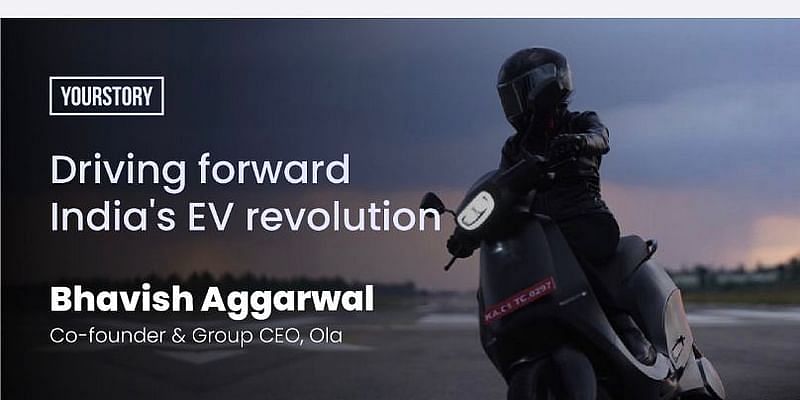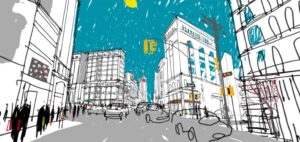In the past few months, even as Bengaluru was slowly recovering from the brutality inflicted by COVID-19, about 140 km away, at a large factory spread across 500 acres of land, there is hope being engineered.
More precisely, around 4,000 workers have been toiling away relentlessly to ensure Ola Future Factory is ready to manufacture its first batch of two million electric vehicle (EV) scooters by 2021-end and spearhead India’s green revolution — a promise that seemed a tad audacious when Ola Co-founder and Group CEO Bhavish Aggarwal initially announced the company’s ambitious plan to lead India’s EV revolution nearly four years ago.
“At the time, EVs weren’t the hot topic as it is today. People were ridiculing everyone who got into EV. But we believed India should take a leadership stance in the world in the space,” Bhavish tells YS in an exclusive interaction.
And that’s the bold dream, powered by a relentless drive to disrupt and take on challenges, that has shaped Bhavish Aggarwal’s pursuit of defining the future of mobility.
He did it in 2010 when Ola first started its ride-hailing business. And now in 2021, he is doing it again with Ola’s Mission Electric, where he envisions all two-wheelers in India will be EVs by 2025.
“For us to be a leader in the world, we have to lead the technologies of the future to build them in India. We have to build world-class products from India, and I believe, Indians have the best talent and access to capital and now the market. It is with that vision that we started Ola Electric,” he says.
To be clear, Ola Electric has a very clear mandate — ‘Create a revolution of putting Ola Electric on the global map.’
This model of innovation and disruption mirrors Bhavish’s early years as an entrepreneur and innovator. When Ankit Bhati and Bhavish started Ola 10 years ago, their biggest disruption was the shared-mobility business model.
“We executed and scaled that business, and today, we are one of the top shared mobility companies in the world. But our bigger ambition has always been to build sustainable, safe, and accessible mobility for everybody. And that isn’t just restricted to mobility services,” Bhavish adds.
Mobility plus
Ola Electric announced the launch and prices of its much-awaited electric scooter — S1, with two variants S1 and S1 Pro, on the 75th Indian Independence day. The scooters will be available for purchase from September 8, and deliveries will begin in October. The Ola S1 and Ola S1 Pro are priced at Rs 99,999 and Rs 1,29,000, respectively.
Moreover, the company is planning to manufacture 10 million two-wheelers by 2022, and its Phase I has an annual production capacity of two million.
In short, Ola Electric aims to build a complete electric vehicle ecosystem in the next few years in India.
Giving a tour of his office, Bhavish shows the room where the scooters were designed. “These sketches you see are made by the team. Each one has been designed keeping the Indian consumer and India like markets in mind,” he says.
While the team had acquired the Amsterdam startup Etergo to launch electric two-wheelers in May last year, Bhavish adds the design, body, and every engineering aspect of the vehicle is now changed.
Bhavish and his team at Ola have been doing all of this besides operating the shared mobility division in tandem. Recently, the team launched Ola Cars, a used-car retailing segment.
At present, the mobility company is planning to sell electric two-wheelers, three-wheelers, and cars, and will also mark its entry into the auto retail sector soon.
Bhavish clarifies that the belief that Ola’s mobility business is running on auto-pilot is not completely true. He adds the mobility business, while hit during the pandemic, is seeing strong growth, reportedly, close to 70 percent.
Bhavish adds, “We have acquired tens of millions of new customers in the period of the pandemic, who were never on our platform, and their usage increased as the pandemic raged on.”
A new market need
Bhavish says the COVID-19 pandemic has changed the future of mobility in India. He adds, “If you look at the future of mobility, personal mobility and shared mobility will remain key solutions. We want to build future paradigms of technology in all of these segments.”
In the personal mobility segment, Ola Cars has been a step forward. Echoing this sentiment, a McKinsey & Company report states — “As the pandemic continues, physical distancing will have a significant impact on mobility behaviour and preferences. Many people will switch to a transport mode that reduces the risk of infection, but the exact shifts will largely depend on their pre-COVID-19 habits.”
The report further said, “People who own a private vehicle will use it increasingly… Evidence from Chinese cities confirms that private cars, walking, and biking have gained the most share since the pandemic began, while bus and subway ridership declined.”
Bhavish says while users now are focused on personal mobility, the world and the younger generation “is looking for a mobility solution of the future.”
Bhavish ready to test ride the Ola S1 electric scooter
Make personal mobility sustainable
“While consumers are now looking at faster and better solutions, the automobile world remains what it was several hundred years back. And to bring that shift, we have focussed on electric as a form of mobility,” adds Bhavish.
Close to three-and-a-half years ago, Ola had announced a large project in Nagpur to build a mass mobility ecosystem. It had tied up with the likes of Mahindra and Mahindra, Tata Motors, Kinetic, BYD, and TVS, among others.
Following the India launch, Ola Electric will be launching the two-wheelers in markets similar to India soon.
This also means cracking into a strong European market. According to a February 2021 Wall Street Journal article, Europe’s share of electric vehicle sales doubled to 43 percent in 2021, and the US and China lost the market share.
In Europe, Volkswagen VW ID4 has become the continent’s top-selling full-electric car. Renault’s Zoe has, in fact, been cracking into Tesla and Volkswagen sales.
However, Bhavish is unfazed by the competition. He says,
“We will start with India like markets soon, and we will start with the two-wheelers. There is a latent need for electric two-wheelers even in these markets, and there are yet to be players that have cracked it. Our product is at the top in terms of design, technology, and power. I guarantee even the top companies haven’t looked at EV the way we have.”
The Ola S1 Pro range
Why reinvent the wheel?
Ola realised that to make EV a part of everyday norm and consumption, the scale was the key. “The Nagpur pilot was a multi-modal pilot. We had a charging network and a swapping network. The pilot taught us that there was a need to build a complete ecosystem,” recollects Bhavish.
It was then the team decided to take a different effort to build an EV mobility ecosystem.
Bhavish says the idea is to solve the problem fundamentally and scale — from the supply-chain and core technologies to the R&D talent.
“This business cannot be built by selling 2,000 vehicles in a year; it needs an industry disruption,” he adds.
While most of the larger players like Tesla or Neo are working on the premium segment, Bhavish says a majority of people aren’t keen on buying luxury products or large SUVs and sedans.
The team at Ola doesn’t believe shared mobility will replace personal mobility. People will have different mobility needs, and some will be fulfiled with shared mobility.
Bhavish says, “But, in future, people will have private ownership of cars or vehicles, and the nature of those vehicles will evolve and they will become sustainable. Electric vehicles will be more connected, and the concept of a vehicle will change. Electrification technology is not just a means of making the vehicle clean, it’s a means of reimagining what a vehicle can be. It can increasingly drive itself, or maybe we can have a different type of space arrangement inside connected to the cloud.”
“Nobody in the world is solving the meat of the market. We believe we have a very unique opportunity to put India on the world map by focusing on urban mobility vehicles and building electrification and making India the world’s hub for electric vehicle production for urban mobility,” he says.
YS’s flagship startup-tech and leadership conference will return virtually for its 13th edition on October 25-30, 2021. Sign up for updates on TechSparks or to express your interest in partnerships and speaker opportunities here.
For more on TechSparks 2021, click here.
Applications are now open for Tech30 2021, a list of 30 most promising tech startups from India. Apply or nominate an early-stage startup to become a Tech30 2021 startup here.



![Read more about the article [Funding alert] Edtech startup Clever Harvey raises $1.5M in pre-Series A round](https://blog.digitalsevaa.com/wp-content/uploads/2021/07/startup-funding-1604990423185-1607520206686-1625202412271-300x150.png)




